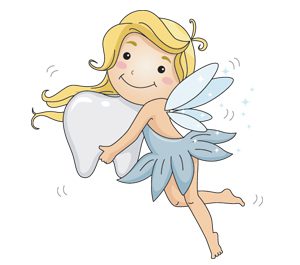 Most people can recall the excitement of losing a tooth in their childhood because it meant that they would be visited by the Tooth Fairy, a mythical being who would replace the lost tooth under their pillow with a small payment. Although this being is contemporarily depicted in the United States as a cute female fairy who flies about collecting teeth during the night, the Tooth Fairy has taken many forms throughout history and may have originated from some interesting traditions.
Most people can recall the excitement of losing a tooth in their childhood because it meant that they would be visited by the Tooth Fairy, a mythical being who would replace the lost tooth under their pillow with a small payment. Although this being is contemporarily depicted in the United States as a cute female fairy who flies about collecting teeth during the night, the Tooth Fairy has taken many forms throughout history and may have originated from some interesting traditions.
What to Do with Lost Teeth: Early Superstitions
What a child does with his or her baby teeth that fall out has long been a subject of interest to people all over the world. An old English tradition required a child to take a tooth that fell out and drop it into a fire so they would not have to go in search of it after their death. Others believed that teeth, along with nail and hair clippings, should be burned so that witches and other evil beings couldn’t use these items to control or harm the person they belonged to. A ritual from Japan had children throw their lost upper teeth straight down to the ground and their lost lower teeth straight up into the air in hopes that their teeth would grow in straight. Some people believed that if children fed their baby teeth to mice or rats their adult teeth would grow to be strong like those of rodents. The proper disposal of teeth was a big deal, and it has been speculated that the Tooth Fairy and similar folktales were brought to life as an answer to what children should do with their lost teeth.
The Evolution of Traditions
The concept of replacing lost baby teeth with a gift or money may have been established as a way to make up for the loss of the tooth and make it less scary for the child. This reward for starting to grow up, a sort of rite of passage, lessens the daunting experience of losing teeth by turning it into something for children to be excited about. Traditions of children being paid for losing their teeth have been recorded in documents as early as the Eddas of the thirteenth century.
Nineteenth century folktales from multiple countries around the world involve a mouse replacing baby teeth under the child’s pillow with a gift, and this custom is still passed down through the generations in many of these countries today. This tradition may have evolved from the superstition that the mouse eating their teeth would give them strong adult teeth similar to the characteristically strong teeth of rodents.
The story of the Tooth Fairy that is now commonly taught to children in North America and Australia may have developed from the tradition of the tooth mouse and evolved from this rodent into a fairy during the twentieth century. Perhaps these cultures chose a fairy as the being that sneaks into their children’s rooms at night because they believed that a fairy would be more comforting to a child. Mice are often associated with disease, and fear of mice is one of the most common specific phobias. A fairy as the fantasy figure rather than a mouse also makes the tradition more magical. The belief in magic is often associated with childhood innocence, which many parents try to preserve as the child is beginning to grow up.
After this professional tooth-collecting fairy made her debut, she grew in popularity in America and became a widespread custom by the 1950s. She helped bring attention to the importance of children’s dental hygiene and has appeared in several plays, books, cartoons, and even on pillows, blankets, and other merchandise. Since then parents have been cheerfully introducing the Tooth Fairy into their family life. Whether you picture the Tooth Fairy as a pixie, a child with wings, a flying ballerina, or a dental hygienist, this mythical being often ameliorates the distress and anxiety that can accompany a child’s loss of baby teeth while creating an American tradition that will likely carry on for generations.
If you have any questions or concerns about your or your child’s dental health, please contact Dr. Kevin B. Sands, DDS, at his Beverly Hills cosmetic dentistry office. Feel free to call (310) 273-0111 or fill out our online contact form today.